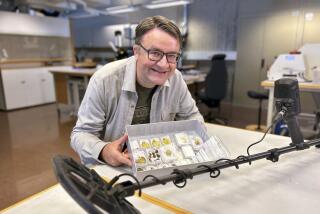Carlsbad Man Hopes to Nail Down a Craze
- Share via
Englishman Steve Ward was toiling away in the banger business when a peculiar 2,000-year-old opportunity suddenly came his way.
Just as he was endeavoring to get San Diego County’s appetite hooked on bangers, those plump British sausages, he managed to buy 30,000 ancient Roman nails discovered 30 years ago at a fortress in Scotland.
Ward’s accountant, who helped arrange the purchase, also issued a challenge: “He said, ‘Do you think you can get the Americans excited about these nails?’ ”
Ward, a former race-car driver, figured that, if Americans went wild for Pet Rocks in the ‘70s, they might really gobble up something of antiquity. Even if they’re nails. And even if they sell for $189 apiece.
“I’m confident that anybody with a reasonable amount of intelligence will know this is a good thing to own,” said Ward, who, as a sideline to his sausage distribution business, British Banger
Corp., has now opened A.D. Discoveries in Carlsbad to market the nails.
He figures the nails are more than a mere curio for somebody who has everything, saying, “How often can you pick up something that’s 2,000 years old?”
A buyer at the Nordstrom department store in Santa Barbara thinks Ward may be on to something and has ordered 50 of the nails, which are sealed in Lucite and resting in a velvet-lined oak box, to offer for Christmas.
“We feel our Santa Barbara customers have responded (in the past) to merchandise of nostalgic or keepsake value,” said Nordstrom spokeswoman Michelle Garratt.
Ending up on department store shelves probably isn’t the worst thing that might have happened to the nails. They literally could have killed somebody.
Back in AD 83, a Roman army commanded by Agricola had trudged through Britain up to Caledonia, now Scotland, to subdue the tribes there, according to a history book Ward keeps. The Roman leader ordered a fortress built in Perthshire, but it was later abandoned and destroyed by the departing Romans.
Roman equipment was buried at the fortress, including 8 tons of nails the legion didn’t want captured, pounded into arrowheads, and fired back at them by the highly agitated locals whose lands the Romans had the bad manners to invade.
The nails remained in a pit for centuries, covered by 12 feet of clay, until 1960.
Then, the British Steel Corp. discovered the cache during an excavation at the site. The top layers were corroded, but had formed a protective cap that kept the rest of the nails from exposure to air.
The steel firm kept the nails until the 1980s, and Ward produces a letter on British Steel Corp. stationary stating, “You have our assurance . . . (the nails) are all Roman nails from the legionary fortress of Inchtuthil, Perthshire dated from AD 83 to AD 87.”
Ward, 36, born in Yorkshire, said the nails have been extensively studied and authenticated since their discovery, and he provides buyers with a booklet citing the scholarship done on the nails. They are two lengths: 3 to 4 inches, and about 2 inches.
At this point, just as the nails are going on the market, Ward has no idea whether his investment gamble will be a financial debacle or a brilliant stroke. But he simply couldn’t pass up the opportunity that “just came about by accident.”
Last May, his accountant, Tony Redpath, told Ward that he had a client in northern England who had come into possession of the nails and was willing to sell. Ward bought them, got an import license, and brought them to the United States.
When a U.S. Customs agent inquired what he had, Ward said, “You promise not to laugh? They’re rusty nails.”
Now they’re for sale, and Ward hopes the items will take off. Ward’s friend, Nick Reed, a 27-year-old Briton, is ready to market the nails in their native country.
“If someone buys one, they’re not going to see one at a swap meet for $20,” assured Reed.
More to Read
Sign up for Essential California
The most important California stories and recommendations in your inbox every morning.
You may occasionally receive promotional content from the Los Angeles Times.











